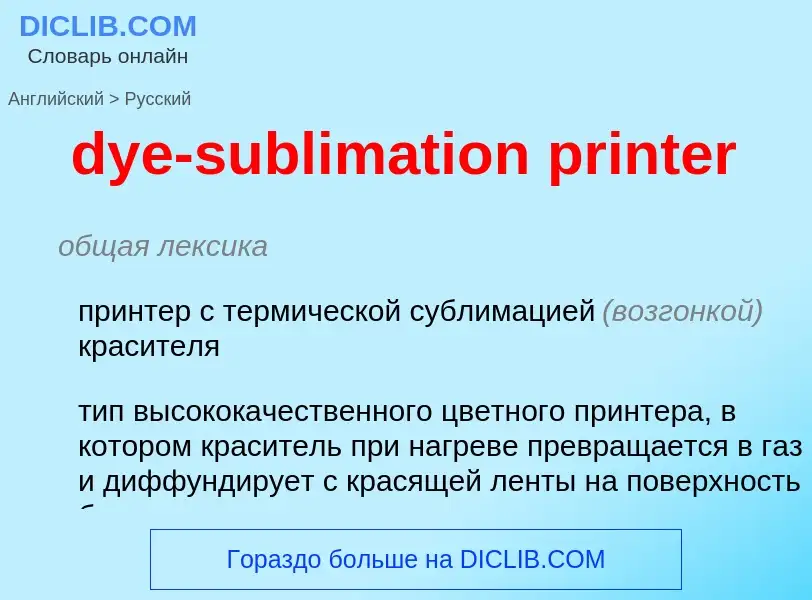Vertaling en analyse van woorden door kunstmatige intelligentie ChatGPT
Op deze pagina kunt u een gedetailleerde analyse krijgen van een woord of zin, geproduceerd met behulp van de beste kunstmatige intelligentietechnologie tot nu toe:
- hoe het woord wordt gebruikt
- gebruiksfrequentie
- het wordt vaker gebruikt in mondelinge of schriftelijke toespraken
- opties voor woordvertaling
- Gebruiksvoorbeelden (meerdere zinnen met vertaling)
- etymologie
dye-sublimation printer - vertaling naar russisch
общая лексика
принтер с термической сублимацией (возгонкой) красителя
тип высококачественного цветного принтера, в котором краситель при нагреве превращается в газ и диффундирует с красящей ленты на поверхность бумаги или кальки
[dai]
общая лексика
краситель
красящее вещество
красить
окрашивать
подкрашивать
краска
красящий
нефтегазовая промышленность
сигнальная цветная присадка к бензину
красить, подкрашивать
Смотрите также
существительное
[dai]
общая лексика
краска
краситель
красящее вещество
окраска
цвет
глагол
общая лексика
(dyed ‹-{dai}d›) красить
окрашивать
окрашиваться
краситься
принимать краску
красить, окрашивать
принимать краску, окрашиваться
синоним
Definitie
Wikipedia

Dye-sublimation printing (or dye-sub printing) is a term that convers several distinct digital computer printing techniques that involve using heat to transfer dye onto a substrate.
The sublimation name was first applied because the dye was thought to make the transition between the solid and gas states without going through a liquid stage. This understanding of the process was later shown to be incorrect, as there is some liquefication of the dye. Since then, the proper name for the process has become known as dye diffusion, though this technically correct term has not supplanted the original name.
Historically, "dye sublimation" referred to page printers that use a thermal printhead to transfer dye from a ribbon directly onto the print media via sublimation. While it originally was used in creating prepress proofs, today this technology survives in ID card printers and dedicated photo printers, often under the name dye diffusion thermal transfer (D2T2).
The term was later also applied to the indirect sublimation transfer printing process, which uses a standard printer to deposit sublimation-capable toner or ink onto a transfer sheet. The printed transfer sheet is then pressed with the substrate with heat, transferring the dye to the substrate, such as plastic or fabric, via sublimation. Thus, this process is indirect, since the final substrate does not pass through the printer, and the sublimation step occurs separately.
The term direct dye sublimation is sometimes applied to a variant of digital textile printing using dye-sublimation inks printed directly onto fabric, which must then be heated to set the dyes, without the use of a transfer sheet.







![[[Epson]] MX-80, a popular model of dot-matrix printer in use for many years [[Epson]] MX-80, a popular model of dot-matrix printer in use for many years](https://commons.wikimedia.org/wiki/Special:FilePath/Epson MX-80.jpg?width=200)
![adj=on}} [[tractor-feed paper]]. They were also called "132-column printers". adj=on}} [[tractor-feed paper]]. They were also called "132-column printers".](https://commons.wikimedia.org/wiki/Special:FilePath/Epson Wide Carriage 9-pin printer - with legal paper 8.5x14.jpg?width=200)








